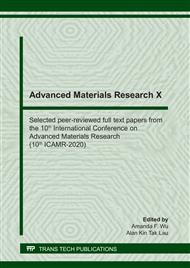p.187
p.193
p.198
p.209
p.217
p.223
p.228
p.235
p.243
Characterization of Silica Extracted from Rice Husk by NIR Spectroscopy and its Application in Separation Science
Abstract:
Rice is one of the major crops and staple food of more than half of the world’s population. Its production generates an abundant by-product, namely rice husk (RH). Rice husk is used as a fuel for power generation. The rice husk ash (RHA) generated during combustion becomes an environmental pollutant and its disposal is difficult. In this work, rice husk was used to produce silica by burning in a furnace at 650°C for 4 hrs. The produced silica was characterized by Near Infrared (NIR) spectroscopy and then used to prepare thin layer chromatography plates (TLC) for testing its efficiency in the separation of organic compounds. The NIR spectrum of rice husk ash showed the presence of combination band of silanol OH stretching and siloxane (Si-O-Si) bending at 4531 and the first overtone of the free silanol groups at 7321 cm-1. The bands are strikingly similar to the bands in NIR spectrum of commercial silica. The silica produced from rice husk ash proved to be an equally effective stationary phase on TLC plates as the commercially marketed silica in the separation of organic compounds. The research work clearly provides not only an alternative source of silica but also provides a solution for the effective use of an environmental pollutant.
Info:
Periodical:
Pages:
243-247
Citation:
Online since:
July 2020
Authors:
Keywords:
Price:
Сopyright:
© 2020 Trans Tech Publications Ltd. All Rights Reserved
Share:
Citation:


